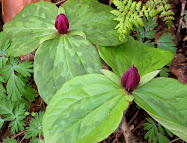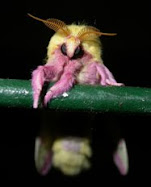Streptopus amplexifolius (White Mandarin)
Tiarella cordifolia (Foamflower)
Trillium undulatum (Painted Trillium)
On the trail we found this birds nest. Inside is lined with deer hair. I wondered if the hair came from a live or a dead deer, there are probably plenty in the area. We suspected that it came from a cavity we found on the side of the hill and replaced it. It probably won’t be used this season but one never knows. Maybe a mouse will find it has all the comforts of home.
I know this was a flower walk but that is one of the good things about naturalist, they stop for everything. This Blister Beetle caught our attention. It is in the family Meloidae and I believe it is a Meloe impressus. You can observe its dark violet color. They are called blister beetles because of their defense mechanism of secreting a blistering agent called cantharidin, a poisonous chemical that will cause the skin to blister. When we first found them there were three and two were getting on top of this one. Mating was suspected but this one was having none of it and ran away leaving the other two confused. The adults feed on pollen. I read that in May to June the female digs into the soil about 1 inch deep where it places about 2,000-10,000 eggs.
Back to the cars and on up to Bickle Knob, we stopped to see the highlights of this trip. First the Stair Step Moss (Hylocomium splendens), a perennial clonal moss. Each year a new feathery frond starts and produces the stepping effect you see below. This makes it possible to estimate the age of the moss by just counting the steps. It is the only moss with this stair step arrangement.
Stair Step Moss (Hylocomium splendens)
Stair Step Moss (Hylocomium splendens)
Knight’s Plume Moss (Ptilium cristacastrensis)
Knight’s Plume Moss (Ptilium cristacastrensis)
Halberd-Leaved Violet (Viola hastate)
Bickle Knob is the home to one of the few remaining observation towers in the Monongahela National Forest. I climbed to the top were I was 4,000 feet in elevation and had a great panoramic view of the mountains.
Wild Columbine (Aquilegia Canadensis)
Another of my favorites was the Wood-betony also called lousewort. Both the red and the yellow form were on the bank beside the road.
Pedicularis canadensis (Wood-betony)
Pedicularis canadensis (Wood-betony)
This was just a small sample of what we found along the road. I would have to write about 5 more blogs to show everything but these were the highlights for me that day.
Stop by Outdoor Wednesday to see how others spent their time outside this week.











































+DSCN5800+for+blog.jpg)



